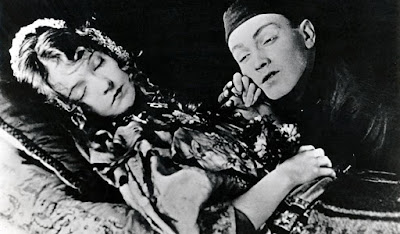1919/USA Dir: D.W. Griffith Key Cast: Lillian Gish, Richard Barthelmess
Based on: The Chink and the Child by Thomas Burke (Short Story)
It's a complicated business looking back at the silent film era. You're looking at a piece of history and the context is far harder to unpick than a contemporary film. D.W. Griffith's The Birth of a Nation is an appallingly racist film but something like Broken Blossoms isn't so easy to define.
On the one hand, there is so much seen through modern eyes which feels awful. The film is based on a short story called "The Chink and the Child" and it's alternative title is "The Yellow Man and the Girl". Throughout the film both characters and the captions use this sort of language. Then there's the fact that the Chinese male lead is played by Richard Barthelmess, a white man wearing 'yellow face' and affecting a squint in the mistaken believe that it makes him look Chinese rather than in need of a an optician.
So on the surface we have a film which is undeniably racist. When you delve a bit deeper though the story is actually one of tolerance. Cheng Huan falls in love with Lucy Burrows (Lillian Gish) and saves her from her abusive father. It's a story of forbidden love and every effort is made to ensure Cheng Huan is perceived as a wonderful man. He only arrives in London the gentle message of Buddhism and does very little you could really criticise him for.
I can't quite work out how these two elements gel together. Once you look past the racist elements of the production side of things, the world of the film actually portrays a positive view of race and difference. I think that whilst I can never forgive the production side of things that they reflect the era the film was made in and I take the view that the message at the heart of this film is a positive one.
In terms of the rest of the production... wow! Unlike many other Griffith film's this is a small-scale affair shot in small studios and full of atmosphere. It does a wonderful job of evoking the atmosphere of East London and also employs every trick in the book to make Gish look as beautiful as possible. From the various Griffith films I've now seen I think I prefer this smaller approach. Sure, he can do sweeping epics with huge sets and hundreds of extras but actually there's far more emotion wrought from focusing on the small details.
For the most part I thought the film was excellent but I couldn't get too comfortable with it because it's attitudes to race in the story don't really come across to the production side of things.

Comments
Post a Comment